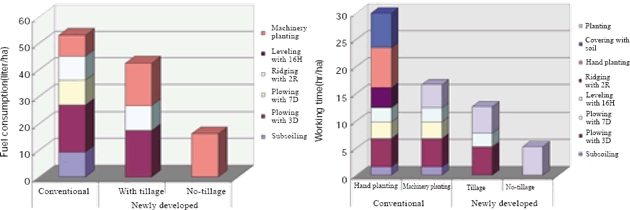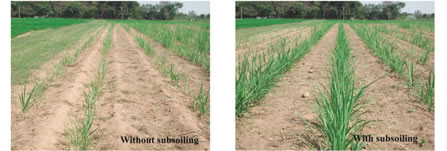Alternative tillage system for upland cropping in Northeast Thailand
Description
[Objectives]
In recent decades, the development of sugarcane cropping in Northeast Thailand has been accompanied by the utilization of heavy machines rather than draft animals. The operation of heavy machinery for land preparation and product transportation damages the physical condition of the sandy soil, which is extremely vulnerable to mechanical and climatic impacts. In this type of soil, it is not unusual to find hardpan soil having bulk density as high as 1.7 in layers 30-40 cm deep; hardpan soil not only aggravates problems of water runoff and erosion through poor water percolation but, through the limitation of root development, also causes crop growth to be more sensitive to environmental stresses.
[Results]
In order to find solutions to this problem, the effects of subsoiling treatment were studied in comparison to the conventional tillage system prevalent in sugarcane cropping in Northeast Thailand. With regard to rainy season cropping, the effects of subsoiling on maize yield were not readily apparent during years of abundant precipitation but were quite profound during years of less precipitation. Furthermore, deeper root development of sugarcane was induced and the survival rate of seedlings during the dry season was found to have increased with subsoiling treatment. Soil erosion was also ameliorated through the high levels of water percolation resulting from subsoiling.
Based on the results above, a new working attachment simultaneously incorporating subsoiling, fertilizing and planting functions was developed by modifying a common sugarcane planter (Fig. 1). A chisel with this attachment was useful in breaking up hardpan up to 60 cm in depth and reducing the hardness of the soil from 23 kg.f/cm2 to less than 10 kg.f/cm2; this enabled sugarcane to be planted without ridging. It was suggested that this attachment could also work well under no-tillage conditions. Under the conventional system for land preparation and planting, fuel consumption and working time amounted to 50 liters and 15 hours per ha. By using the newly developed attachment, the necessary amount of fuel and time could each be reduced by one-third (Fig. 2). Moreover, the number of required tractor operations could be reduced from five times under the conventional system to just once under the new alternative system, which would also contribute towards reducing the formation of hardpan. The rooting of sugarcane was improved through the use of the new attachment under no-tillage conditions and the growth of sugarcane was superior to that under the conventional planting system (Table 1).
In order to make this system practical and applicable to upland cropping in Northeast Thailand, it is necessary to conduct further studies on the management of sugarcane residue and the control of weeds during the fallow period after the end of ratooning.
Figure, table
-
Fig. 1. Comparison of fuel consumption and working times among several planting systems. -
Fig. 2. Effects of subsoiling treatment on the growth of sugarcane planted under no-tillage conditions. -
Table 1. Effects of planting methods with/without tillage on the growth of sugarcane.
Note: Sampling was carried out on Sept. 10th 2002. Stalk diameter was determined at the middle of stalk. The values in the table indicate average ± S.E. (n=4). F.W.:Fresh weight
- Affiliation
-
Japan International Research Center for Agricultural Sciences Crop Production and Environment Division
- Classification
-
Technical A
- Term of research
-
FY2001 (FY1999-2001)
- Responsible researcher
-
MATSUO Kazuyuki ( Crop Production and Environment Division )
WONGWIWATCHAI Chairoj ( Khon Kaen Field Crop Research Center )
YASHIRO Mikio ( Tohoku Agricultural Research Center, NARO )
- ほか
- Japanese PDF
-
2001_05_A3_ja.pdf836.43 KB
- English PDF
-
2001_05_A4_en.pdf119.95 KB



